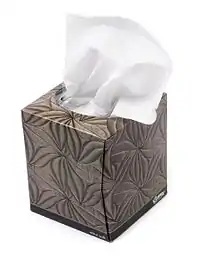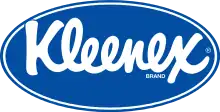Kleenex
Kleenex is a brand name for a variety of paper-based products such as facial tissue, bathroom tissue, paper towels, tampons, and diapers. Often used informally as a genericized trademark for facial tissue in the United States, the name Kleenex is a registered trademark of Kimberly-Clark Worldwide, Inc. Kleenex products are manufactured in 30 countries and sold in more than 170 countries. Kleenex brands include Cottonelle, Huggies, and VIVA. This is not to be confused with the brand "Klinex", a Unilever brand that specialises in detergents. [1]
 | |
 A box of Kleenex facial tissues | |
| Product type | Facial Tissue |
|---|---|
| Owner | Kimberly-Clark |
| Country | United States |
| Introduced | July 12, 1924 |
| Markets | Worldwide |
| Previous owners | International Cellucotton Products Company |
| Registered as a trademark in | USA |
| Website | www |
History
Kleenex began during the First World War. It developed a crepe paper used as a filter for gas masks. In the early 1920s, it was adapted as a consumer product called Kotex brand to help women with their periods.[2]
The first Western facial tissue was introduced in 1924 and originally marketed as a way to remove cold cream (it had already been in use in Japan for centuries; see History of facial tissue for details).[3] It was a disposable substitute for face towels or cotton wool. In 1925, the first Kleenex tissue ad was used in magazines showing "the new secret of keeping a pretty skin as used by famous movie stars." A few years after the introduction of Kleenex, the company's head researcher tried to persuade the head of advertising to try to market the tissue for colds and hay fever. The administrator declined the idea but then committed a small amount of ad space to mention of using Kleenex tissue as a handkerchief. By the 1930s, Kleenex was being marketed with the slogan "Don’t Carry a Cold in Your Pocket" and its use as a disposable handkerchief replacement became predominant.[4] In 1943, Kleenex began licensing the Little Lulu cartoon character to popularize the brand.[5]

Kleenex trademark

The original Kleenex trademark application at the United States Patent and Trademark Office (USPTO) was filed in the class of Medical, Beauty, & Agricultural Services by Cellucotton Products Company of Neenah, Wisconsin, on Saturday, July 12, 1924. The description provided to the USPTO was "absorbent pads or sheets for removing cold cream."
The first use for the drawing and stylized word mark in commerce was on June 12, 1924. USPTO granted trademark registration on November 25, 1924. International Cellucotton Products Company officially assigned trademark interest and good will of the business to Kimberly-Clark Corporation on September 30, 1955. Kimberly-Clark Corporation of Neenah, Wisconsin is the current registered owner of the Kleenex trademark.[6]
In the US, the Kleenex name has become—in common usage but not in law—genericized: the popularity of the product has led to the use of its name to refer to any facial tissue, regardless of the brand. Many dictionaries, including Merriam-Webster and Oxford, now include definitions in their publications defining it as such.[7][8]
See also
References
- https://www.klinex.gr/
- "The Kleenex Story". Kleenex Official Site. Retrieved 15 June 2020.
- "Toilet Paper History – Complete Historical Timeline" Archived 2016-10-07 at the Wayback Machine. The Complete History of Toilet Paper, Unabridged: "In 1924. Kleenex is introduced by Cellucotton and first marketed to women as a disposable towel to use when removing cold cream."
- "Kleenex Brand Story". Kleenex.com. Archived from Kleenex history the original Check
|url=value (help) on 2010-05-27. Retrieved 2010-06-26. - ""Marge and Lulu: The Art of the Deal," Jennifer Gotwals, Hogan's Alley #15, 2007". Archived from the original on 2013-05-01. Retrieved 2013-03-13.
- "United States Patent and Trademark Office, registration #s 0019194;0022859;0029753;0038458;0408618". 1924-06-12. Retrieved 2010-06-25.
- "Kleenex". Retrieved April 9, 2018.
- "Kleenex". Retrieved April 9, 2018.
External links
| Wikimedia Commons has media related to Kleenex. |